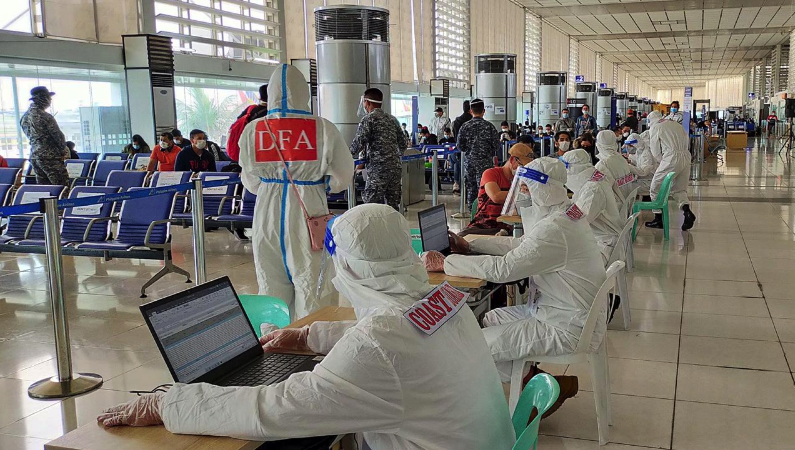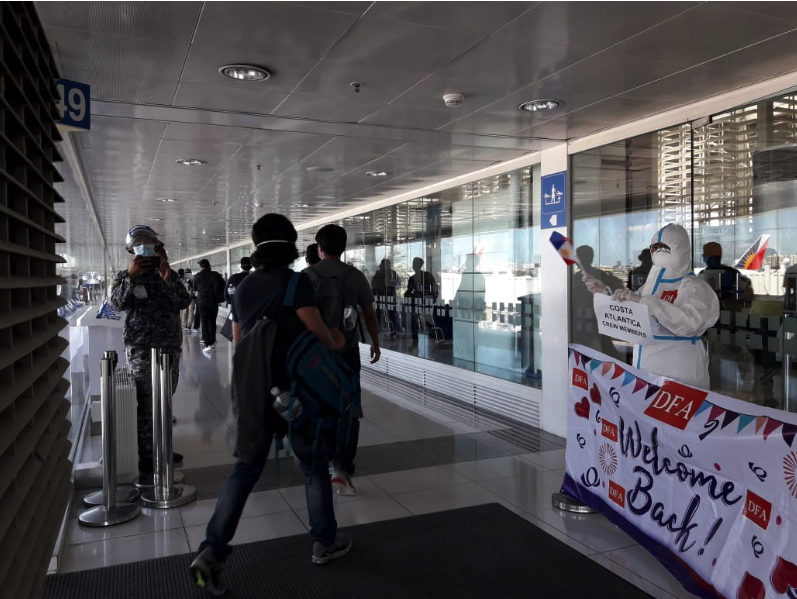
PPEs are a common sign at a Manila airport. Photo: Screenshot from Philippines’ Department of Foreign Affairs website
The almost daily accounts of arrivals of returning Filipino workers read like happy events –homecomings that signal the end of an ordeal at the time of COVID-19. These have been published by the Philippines’ department of foreign affairs, which has been leading these repatriation efforts since early 2020.
But the same is not the case for seafarers who are still out at sea and are unable to go home due to travel and movement restrictions and cancelled or unavailable flights. Pandemic-related restrictions have also made it hard for replacement crews to arrive, with estimates of up to 200,000 stranded at sea globally. Onboard work typically involves two sets of crews in a year with four to six-month contracts, with slightly long work periods for senior personnel.
There are 1.5 million people who work on board ships and vessels of various kinds, and 80 percent of global trade is delivered by sea.
For these seafarers, the pandemic has been a particularly lonely test of mental and emotional resilience, owing to the very nature of their jobs.
Reporting ASEAN talks to Professor Helen Sampson, Director of Cardiff University’s Seafarers International Research Centre, on why this is so.
Question: What is the biggest impact of the pandemic on seafarers?
Sampson: Many seafarers have been forced to work on board for longer than their originally contracted period because crew changes have been halted.
Life at sea is regarded as a sacrifice by the majority of seafarers. They see their lives on board as characterized by privations and hardship. They suffer isolation and stress. As a result, the end of their contracts is something they very strongly look forward to. Many seafarers cross off days on a calendar to mark the time until they can go home.
The day that they leave the ship is experienced as a day of joy…. One seafarer wrote to me in a personal communication that he felt he was being subjected to ‘slavery’ on board. Such was his sense of being forced to stay on his ship working when he wished to leave.
The mental health and wellbeing of seafarers in this context is very concerning.
Q: Are there any issues in the context of the pandemic that are specific to sea-based workers and the nature of the industry as opposed to overseas workers in general?
Sampson: Yes. Most of us are able to make a decision at this moment about whether we will go to work or not, even many overseas workers. Some of us are also able to work from home.
For obvious reasons, seafarers are unable to work from home. Those who were on board in March when the virus became widespread are unable to decide to leave work and go home. Even when their company is able to repatriate them, they may find they are faced with local quarantine rules once they arrive back in their homelands.
The crisis really demonstrates how little autonomy seafarers have once they board a vessel.
Q: Your thoughts on what this could possibly mean for the Philippines, which has the most number of sea-based workers?
Sampson: The global economic downturn related to the coronavirus outbreak is likely to have medium-term effects on the industry, which will be serious. This will inevitably impact on seafarers’ jobs and therefore on remittances. Unfortunately, all economies are likely to suffer some long-term damage.
*This feature is part of the ‘COVID-19 and Southeast Asia’ series published by the Heinrich Boell Foundation Southeast Asia, in collaboration with the Reporting ASEAN programme.




